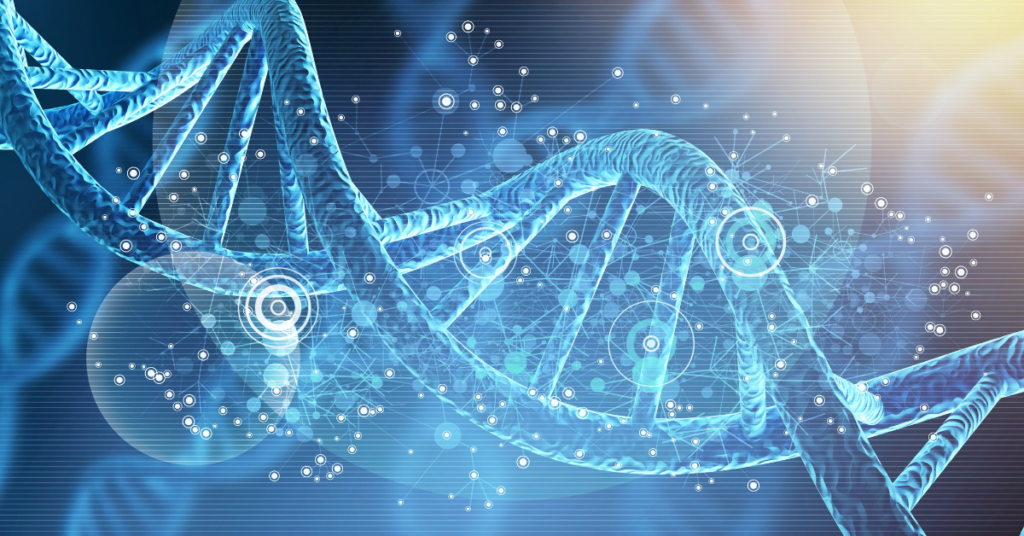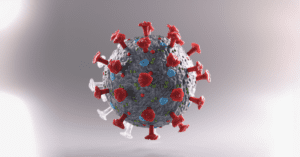
Written By Dr. Hannah K Shorrock
Edited by Dr. Celeste Suart
Accumulating DNA damage without being able to repair it may lead to a cascade of negative effects in SCA7, resulting in neuronal demise and death.
Why do neurons in the cerebellum degenerate in spinocerebellar ataxia type 7? If scientists can find the answer to this question and identify the cellular pathways responsible for neuron death, they can develop targeted treatment strategies to restore those pathways. They could potentially even prevent the pathways from malfunctioning in the first place. This was the question that Switonski and colleagues in the La Spada lab wanted to answer: how and why does neuron degeneration occur in SCA7? The answer, at least to a certain extent, is DNA damage.
Spinocerebellar ataxia type 7, or SCA7, is caused by CAG repeat expansions in the ATXN7 gene, which encodes the ataxin-7 protein. In SCA7, the CAG repeat expansion in the ATXN7 DNA leads to a polyglutamine expansion in the ataxin-7 protein and this disrupts the normal function of ataxin-7. Proteins fold in very intricate and specific ways so that they can bind – very specifically – to the proteins and other cellular components they are meant to interact with to enable the proteins to carry out their normal function. When proteins carry out their normal functions this keeps cells and neurons healthy.
Normal ataxin-7 contains four to 35 glutamine amino acids in a row. In SCA7, ataxin-7 contains 37 to more than 400 glutamine amino acids in a row. Not surprisingly, having this many extra amino acids affects how the ataxin-7 protein folds and functions. This in turn can disrupt the balance of protein function that keeps cells and neurons healthy. So, what does ataxin-7 normally do?
Finding a link between ataxin-7 and DNA damage and repair pathways
Ataxin-7 is a core member of a complex called the STAGA co-activator complex. STAGA is made of many proteins that work together to control the transcriptional and chromatin landscape in cells. In other words, STAGA makes sure that the regions of DNA that need to be expressed (or transcribed) are accessible and that the regions of DNA that are not needed are tucked away in tightly wound balls of DNA known as chromatin. This is coordinated by histones: proteins that package the DNA into the tightly wound balls for storage. The STAGA complex contributes to controlling DNA accessibility by altering the amount of acetylation on histones present at specific regions of the DNA. If the DNA needs to be used – or come out of storage – marks are made on the histones by a process called acetylation and the DNA becomes accessible.
In SCA7, the researchers found increased histone acetylation at promoter regions of genes involved in DNA damage and repair pathways. The promoters signal for the following gene to be turned into mRNA so it can be made into protein. Not surprisingly then, the researchers found that genes with increased promoter histone acetylation had increased expression. In other words, in SCA7, these sections of DNA which should be in storage are taken out of storage, and used, more than they should be. This suggests that mutant ataxin-7 changes how the STAGA complex normally functions, resulting in differences in DNA accessibility and increasing the expression of genes involved in DNA damage and repair.
Since the researchers saw an increase in the expression of DNA damage and repair genes linked to disruption of how ataxin-7 normally functions, they asked two questions:
- Is the SCA7 mutation sufficient to induce DNA damage?
- Does the SCA7 mutation lead to impairment of DNA repair pathways?
The researchers hypothesized that alterations to DNA damage and repair lead to a cascade of events that result in the dysfunction and demise of neurons in SCA7. To test this hypothesis and answer these questions, the researchers used a variety of model systems including patient-derived neuronal precursor cells, granule cell neurons cultured from mouse cerebellum tissue, and basic cell culture systems. Then the researchers introduced extra sections of DNA to express normal or mutant ataxin-7 protein in these cells.
Increase in damage, reduction in repair
The researchers looked at the amount of gH2AX in cells to answer the first question: is the SCA7 mutation sufficient to induce DNA damage? gH2AX is a specific marker for DNA double-strand breaks, one type of DNA damage. They first looked at cells that expressed added normal or mutant ataxin-7. They found increased levels of gH2AX in cells expressing mutant ataxin-7 compared to cells that express normal ataxin-7.
While this suggests that DNA damage is increased in SCA7, the process of introducing extra DNA to cells causes some cellular stress. Because of this, the researchers next looked at models that expressed normal or mutant ataxin-7 without having to introduce extra DNA:
- Control and SCA7 patient-derived neuronal precursor cells
- Granule cell neurons cultured from wild-type and SCA7 mice.
In both systems, the researchers found increased levels of gH2AX. This shows that the SCA7 mutation is sufficient to induce DNA damage in the absence of any added cellular stress.
Normally when damage occurs to DNA, the cell turns on pathways that repair that damage. There are several different DNA repair pathways that a cell can use depending on the type of DNA damage that needs repairing. To answer the second question – does the SCA7 mutation affect DNA repair pathways? – the group used a reporter system that tests whether each DNA repair pathway is working individually. If the DNA repair pathway that corrects a specific form of DNA damage works, the cell will express green fluorescent protein from the reporter.
The group found that two types of DNA repair do not function correctly in SCA7: homology-directed repair and single-strand annealing repair. Together, they found that this led to an increase in exon-containing DNA being attached, or translocated, to other sections of DNA when mutant ataxin-7 is expressed by cells. As exons are the regions of DNA that code for proteins. This could lead to a variety of effects on the RNA and proteins normally produced from these sections of DNA.
What happens when damage accumulates?
If some DNA repair pathways are still functional, why would the DNA damage lead to neurons becoming sick and not functional? To answer this question, let’s imagine this scenario: If you find lots of water on the floor of your kitchen, there are several people you might call to help depending on where the water is coming from – a hole in your roof? Call a roofer; a leak under your sink? Call a plumber; has the water pipe broken and flooded your street? Call the local water authority. In each case, you need the correct knowledge, tools, and, in some cases authority, for the job. If the water main is burst, a roofer couldn’t help. Likewise, the local water authority is unlikely to repair a hole in your roof.
DNA damage and repair are much the same. If you accumulate damage to DNA and the repair pathways that normally correct that type of damage does not work, the DNA damage (or the water on your kitchen floor) will accumulate. Over time, this will lead to a cascade of detrimental effects: after a flood, do you need to replace the food and supplies in your lower kitchen cupboards? does your flooring need replacing? or do you need to completely replace your kitchen? Unfortunately, neurons cannot be replaced. They can mitigate some of the detrimental effects for a while but over time, but the neurons will continue to accumulate damage until they are no longer functional and will eventually die.
This work is a culmination of many years of research trying to understand how and why neurons die in SCA7. To begin to understand this, it was first necessary to understand what the normal ataxin-7 protein does. With an understanding of what normal ataxin-7 does, it is then possible to investigate how this is disrupted in SCA7 and what the effects of this are on the cell. Over time, this research has identified cellular pathways that are affected in SCA7. We can now begin to understand how best to correct the damage to those pathways, prevent cascades of detrimental effects, and ultimately, hopefully, improve neuronal survival.
Key Words
Exon: regions of the genome that are present in the mature mRNA. Proteins are coded for by the genetic material located in exons. Not all exons code for proteins.
Homology-directed repair: a DNA repair pathway that fixes double-strand DNA breaks by using a very similar piece of DNA as a template for the repair. This process is generally error free if the DNA template is identical to the original DNA sequence that is being repaired.
Single-strand annealing repair: a DNA repair pathway that fixes double-stand DNA breaks that occur between two repeating sequences. A single DNA strand is made on each side of the DNA break and because the repetitive sequences on each side of the break match, these sequences stick together (anneal). This leads to a shortening of the DNA sequence because the region between the two repeating sequences is lost.
Conflict of Interest Statement
The author and editor declare no conflict of interest.
Citation of Article Reviewed
Switonski, P. M., J. R. Delaney, L. C. Bartelt, C. Niu, M. Ramos-Zapatero, N. J. Spann, A. Alaghatta, T. Chen, E. N. Griffin, J. Bapat, B. L. Sopher and A. R. La Spada (2021). “Altered H3 histone acetylation impairs high-fidelity DNA repair to promote cerebellar degeneration in spinocerebellar ataxia type 7.” Cell Rep 37(9): 110062.
Read Other SCAsource Summary Articles

Los científicos desarrollan un nuevo enfoque para evaluar la Ataxia en casa
Escrito por Ziyang Zhao Editador por la Dra. Hayley McLoughlin Traducido por Ismael Araujo Aliaga Una aplicación para teléfonos inteligentes recientemente desarrollada permitirá a los pacientes evaluar la ataxia en casa. Existe Read More…

The SCA2 Chronicles: Unmasking COVID-19’s impact on Mind and Movement in a Galaxy Not So Far Away
Written by Kaitlyn Neuman Edited by Celeste Suart, PhD Lessons from a global pandemic: COVID-19 negatively impacts speech function and mental health in SCA2 patients. A short time ago, in a Read More…

Online Speech Therapy program helps improve speech in ataxia
Written by Caroline Spencer, PhD Edited by Celeste Suart, PhD ClearSpeechTogether is a virtual group-based speech therapy program for people with speech problems due to progressive ataxia. In this article, researchers Read More…










